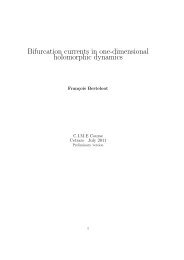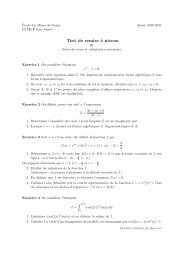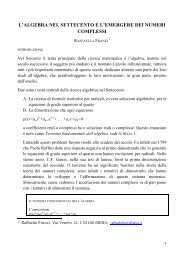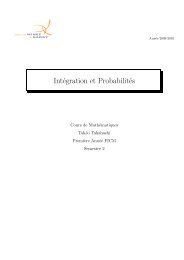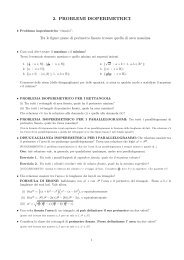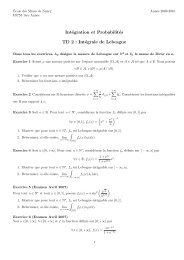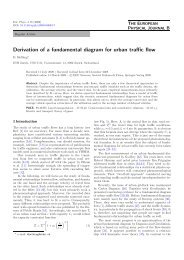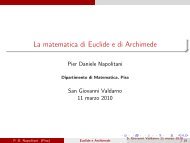on carleman estimates for elliptic and parabolic operators ...
on carleman estimates for elliptic and parabolic operators ...
on carleman estimates for elliptic and parabolic operators ...
Create successful ePaper yourself
Turn your PDF publications into a flip-book with our unique Google optimized e-Paper software.
CARLEMAN ESTIMATES 21<br />
The ψDO symbolic calculus gives B ∗ ◦ B = Re Op(a) − LΛ m + hR, with R ∈ Ψ m−1 , where Re Op(a) actually<br />
means (Op(a) + Op(a) ∗ )/2. We then have<br />
Re(Op(a)u, u) = (Re Op(a)u, u) ≥ L(Λ m u, u) − h(Ru, u) ≥ L‖Λ m/2 u‖ 2 0 − hL ′ ‖u‖ 2 (m−1)/2<br />
We c<strong>on</strong>clude the proof by taking h sufficiently small.<br />
≥ (L − hL ′ )‖u‖ 2 m/2 .<br />
<br />
A.2. Example of functi<strong>on</strong>s fulfilling the sub-<strong>elliptic</strong>ity c<strong>on</strong>diti<strong>on</strong>: proof of Lemma 3.3. We shall actually<br />
prove the following str<strong>on</strong>ger lemma here.<br />
Lemma A.1. Let V be a bounded open set in R n <strong>and</strong> ψ ∈ C ∞ (R n , R) such that |ψ ′ | > 0 in V. Then <strong>for</strong> λ > 0<br />
sufficiently large, ϕ = e λψ satisfies |ϕ ′ | ≥ C > 0 in V <strong>and</strong><br />
(A.2) ∀(x, ξ) ∈ V × R n , q 2 (x, ξ) = 0 ⇒ {q 2 , q 1 }(x, ξ) ≥ C > 0.<br />
Proof. The computati<strong>on</strong> of the Poiss<strong>on</strong> bracket {q 2 , q 1 } = ∑ j ∂ ξ j<br />
q 2 ∂ x j<br />
q 1 − ∂ x j<br />
q 2 ∂ ξ j<br />
q 1 gives<br />
{q 2 , q 1 } = 4 ∑ ϕ ′′<br />
j,k (ξ jξ k + ϕ ′ j ϕ′ k ) = 4(ϕ′′ (ξ, ξ) + ϕ ′′ (ϕ ′ , ϕ ′ )).<br />
1≤ j,k≤n<br />
Here we have ϕ = e λψ , <strong>and</strong> thus ϕ ′ = λϕψ ′ <strong>and</strong> ϕ ′′<br />
jk = λϕψ′′ jk + λ2 ϕψ ′ j ψ′ k<br />
, j, k = 1, . . . , n, which yields<br />
{q 2 , q 1 } = 4λ 3 ϕ 3 ( λ|ψ ′ | 4 + ψ ′′ (ψ ′ , ψ ′ ) + ψ ′′ ((λϕ) −1 ξ, (λϕ) −1 ξ) + λ −1 ϕ −2 〈ψ ′ , ξ〉 2) .<br />
When q 2 = 0 we have |ξ| = λϕ|ψ ′ |. We then note that<br />
We deduce<br />
|ψ ′′ ((λϕ) −1 ξ, (λϕ) −1 ξ)| ≤ C|ψ ′ | 2 , |ψ ′′ (ψ ′ , ψ ′ )| ≤ C|ψ ′ | 2 .<br />
{q 2 , q 1 } ≥ 4λ 3 ϕ 3 ( λ|ψ ′ | 4 − C|ψ ′ | 2) .<br />
We then see that <strong>for</strong> λ sufficiently large we have {q 2 , q 1 } ≥ C λ > 0, since |ψ ′ | ≥ C > 0.<br />
Remark A.2. In Lemma 3.3 we chose to use an exp<strong>on</strong>ential functi<strong>on</strong>. The reader will note that a similar<br />
result can be obtained by taking ϕ = G(λψ), with λ sufficiently large, <strong>for</strong> a functi<strong>on</strong> G : R → R that satisfies<br />
G ′ > 0, G ′′ > 0 <strong>and</strong> G ′′ /G ′ ≥ C > 0. This procedure is often referred to as the “c<strong>on</strong>vexificati<strong>on</strong>” of the<br />
weight functi<strong>on</strong>.<br />
A.3. Proof of Lemma 3.4. For |ξ| large, the property holds since q 2 = |ξ| 2 − |ϕ ′ | 2 <strong>and</strong> since the symbol<br />
{q 2 , q 1 } is <strong>on</strong>ly of order 2.<br />
It remains to prove the result <strong>for</strong> |ξ| ≤ R, with R > 0, i.e. <strong>for</strong> (x, ξ) in a compact set (here x ∈ V). In<br />
a more general framework, c<strong>on</strong>sider two c<strong>on</strong>tinuous functi<strong>on</strong>s, f <strong>and</strong> g, defined in a compact set K, <strong>and</strong><br />
assume that f ≥ 0 <strong>and</strong> f (y) = 0 ⇒ g(y) ≥ L > 0. We set h µ = µ f + g.<br />
For all y ∈ K, either f (y) = 0 <strong>and</strong> thus h µ (y) > L, or f (y) > 0 <strong>and</strong> thus there exists µ y > 0 such that<br />
h µy (y) > 0. This inequality holds locally in an open neighborhood V y of y. From the covering of K by the<br />
open sets V y , we select a finite covering V y1 , . . . , V yn <strong>and</strong> set µ = max 1≤ j≤n µ j . We then obtain h µ ≥ C > 0.<br />
We simply apply this result to ρ/〈ξ〉 4 .<br />
<br />
A.4. Proof of Lemma 3.10. We saw in Secti<strong>on</strong> A.2 that<br />
{q 2 , q 1 } = 4λ 3 ϕ 3 ( λ|ψ ′ | 4 + ψ ′′ (ψ ′ , ψ ′ ) + ψ ′′ ((λϕ) −1 ξ, (λϕ) −1 ξ) + λ −1 ϕ −2 〈ψ ′ , ξ〉 2) .<br />
We observe that q 2 ∆ϕ = ( |ξ| 2 − λ 2 |ψ ′ | 2 ϕ 2) ( λ 2 |ψ ′ | 2 ϕ + λ(∆ψ)ϕ ) , which yields<br />
ρ = λ 3 ϕ<br />
(4ψ 3 ′′ ((λϕ) −1 ξ, (λϕ) −1 ξ) + 2µ(λ|ψ ′ | 2 + ∆ψ)<br />
ξ<br />
2<br />
∣<br />
λϕ∣<br />
+ λ −1 ϕ −2 〈ψ ′ , ξ〉 2<br />
)<br />
+ (4 − 2µ)λ|ψ ′ | 4 + 4ψ ′′ (ψ ′ , ψ ′ ) − 2µ|ψ ′ | 2 ∆ψ ,<br />
<br />
which we can make larger than C λ 〈ξ〉 2 , with C λ > 0 by taking λ sufficiently large.



